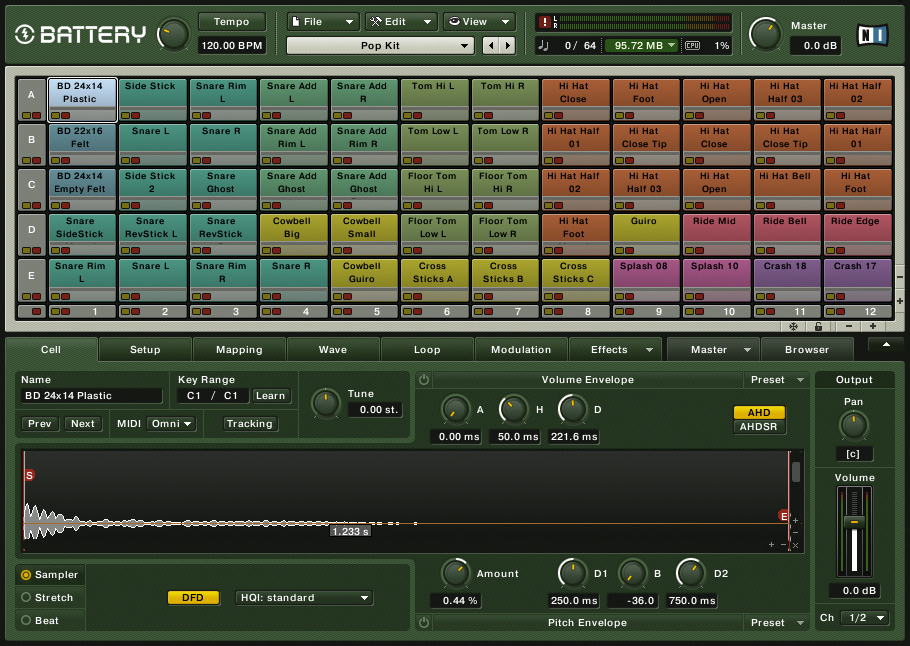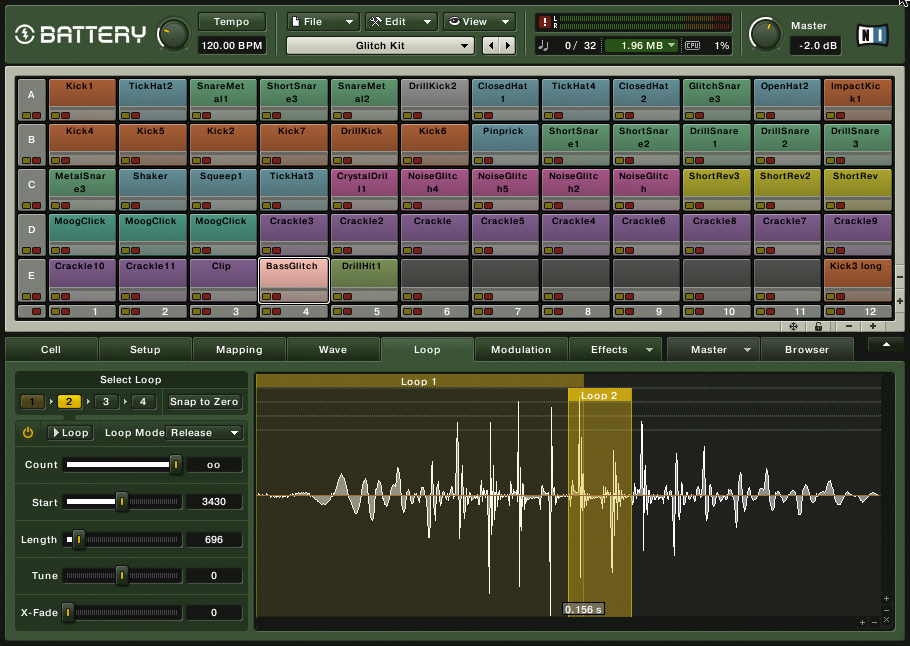MusicRadar Verdict
A good price is the cherry on top of Battery's fantastic cake. All in all, a must-have instrument for anyone who uses beats in their music (that'd be everyone, then).
Pros
- +
Great library. Slick interface. New loop handling. Good new effects. Bundled video tutorials.
Cons
- -
Best played from a MIDI controller. Cell note mapping can be confusing.
MusicRadar's got your back



It's fair to say that the majority of contemporary music is 'sound-driven', and nowhere is this truer than in the area of beats. When you're putting your beats together, any limitations in your software will quickly become apparent. So what's the answer? Quite simply, a job-specific tool, and in this case that means a drum machine. Native Instruments' Battery is one of the finest examples; now at version 3, it's established itself as something of an 'MPC' for the software generation.
To cut right to the chase, Battery 3 is an important update. The sampling engine has been revised and a bunch of improvements bring the software right up to date. As before, it works standalone and as a plug-in on PC and Mac, but it now comes with a 12GB sample library that includes over 100 preset kits. The Battery interface is still dominated by a customisable cell matrix, but this can now include up to 128 cells.
Other new features include a wave editor, cell-specific timestretching, better cell effects and a new master multi-effects section. If you tire of the included library, you can easily expand Battery 3, for it supports a plethora of sampler formats. It can also now handle sliced loops, including those in the Apple Loops and Acid formats.
On the performance front, new features include a humanise option and a selection of drumming articulations. Like a number of its stablemates, Battery 3 has also been given a visual overhaul - the angular, scientific look of earlier versions is gone. NI have added colour-coding options to make cell allocations more obvious, and revamped the browsing and loading options. If all of this sounds a bit much, or you're simply new to Battery, eight step-by-step video tutorials are included to get you going.
The updates
Just as in version 2, Battery's workspace is divided between the aforementioned cell matrix and the edit pane, with the master section running along the top. This makes for a simple layout, and if you want, various parts can be 'folded away'. Factory kits are loaded from the master section or via the full browser tab at the bottom of the screen (kits from all three versions of Battery are grouped in their own sub-menus).
Once you've got a full-on kit patch open, the visual improvements in Battery 3 become clear. Envelope settings come up as shaded areas over the cell waveform and you can view a cell's information simply by waving the cursor over it. In terms of sound, the expanded library is excellent. As well as adding to the natural kits found in version 2, it also extends its coverage into sound design territory, with the Armageddon and Noise kits featuring various impulse-type noises. You can easily import individual cells from these when building up your own sound set.
On the subject of customising, the 'articulations' feature lets you apply standard drum performance techniques (flam, roll, drag and so on) to any cell. This doesn't require any extra samples, though the fact that it takes advantage of different velocity zones means it sounds best when used on multisampled cells. Articulations certainly add to the realism, and the same can be said of the new convolution reverb in the master effects section. Rather cheekily, you can even drag any loaded sample into the convolution window for use as a convolution source!
Want all the hottest music and gear news, reviews, deals, features and more, direct to your inbox? Sign up here.
Beat-downers
With all of its new features, it would be easy to overlook any shortcomings in Battery 3, but inevitably, there's still room for improvement. From a user perspective, to get the most from it, you really need to play it from a MIDI controller. When clicking the mouse, velocity is fixed (though it can adjusted), so there's no context-sensitive playback. This means you can miss out on the multilayered nature of the kits (many of which have 30 or more velocity layers) or the 'note off' cells. What's more, with different kits loading different cell matrix arrangements, it's easy to get confused as to how cells and notes line up.
Ultimately, though, if you use beats in your music-making (like most of the Western world), Battery 3 is a fantastic instrument. Once you've used it, you'll realise just how important a good drum machine is. Sure, you can achieve much of what it offers using a standard sampler, but doing so would undoubtedly take longer. What's more, if you ever get bored, Battery 3 also offers the flexibility and creative tools to keep your beats, loops and any other sounds on the cutting edge. Factor in the fantastic sound set and at £150 it's pretty much a bargain buy.
MusicRadar is the number 1 website for music makers of all kinds, be they guitarists, drummers, keyboard players, djs or producers...
GEAR: We help musicians find the best gear with top-ranking gear round-ups and high- quality, authoritative reviews by a wide team of highly experienced experts.
TIPS: We also provide tuition, from bite-sized tips to advanced work-outs and guidance from recognised musicians and stars.
STARS: We talk to musicians and stars about their creative processes, and the nuts and bolts of their gear and technique. We give fans an insight into the actual craft of music making that no other music website can.
